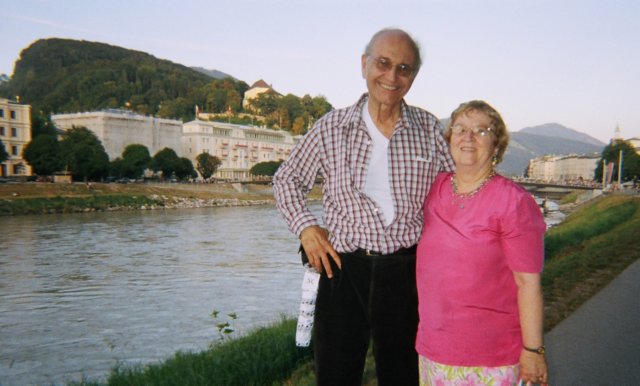| << Previous | Index | Next >> | ||
 |
 |
 |
 |
 |

Kapuzinerberg hill to the left across the river. On Monday morning, I walked up to the top of the hill on a well-constructed trail through the forest and found a great view from the top. I missed the trail to the top on the west (close) side of the hill which begins as a set of stairs up to the monastery. I walked all the way around the south side of the hill to the east end where I found the trail. I walked up the trail back to the west. At the top, I transcribed the english translation of an informational panel on the geology of the area:
Today's Salzburg Basin lies within the Calcareous Alps and comes to an end
in the foreland in the north. The funnel-shape of the basin developed
through the overlap of two geological structures of different age, and
east-west trending structural depression reaching from Salzburg to Bad
Reichenhall (Upper Cretaceous to Upper Tertiary, from 90 to 45 million
years ago), and a younger north-south trending structural depression
reaching as far as Gulling (Lower Tertiary, about 20 million years ago).
The northern and southern boundaries of the older Salzburg Basin are
formed by east-west trending perpendicular fractures. The northern
boundariy is equal to the northern wall of Kapuzinerberg ("Capuchin Hill")
and extends to Kuhberg and Nockstein. During the formation of this basin
lateral shift occurred along these fractures. At the same time parts from
the northern end of the Calcareous Alps were separated and were
transported away from Gaisberg to the west into their present position.
Kapuzinerberg and Festungsberg ("Fortress Hill"), calcareous island
mountains, were then situated within the north-south trending younger
basin. During the formation of this basin the central area underwent
subsidence and the boundaries of the basin slipped down in a step-like
form.
During the last ice age the glaciers have gouged out the basin and
have removed a major part of the soft deposits of the older basin. Only
the limestone rocks of the city hills could withstand the scooping effect
of the Salzach glacier as relic mountains and they still jut out from the
plain.
- Dr. Christian Uhlir
Created with Web Album Generator